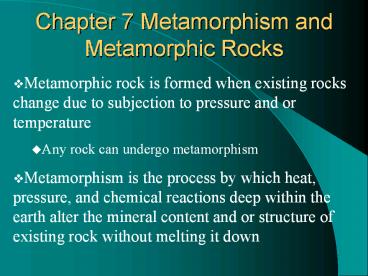Chapter 7 Metamorphism and Metamorphic Rocks - PowerPoint PPT Presentation
Title:
Chapter 7 Metamorphism and Metamorphic Rocks
Description:
... muscovite -low grade (low P/T ... Hornsfel Mixed Rock Migmatite- indicates partial melting Quartz-Sandstone Metamorphism Temperature & Pressure Information about ... – PowerPoint PPT presentation
Number of Views:228
Avg rating:3.0/5.0
Title: Chapter 7 Metamorphism and Metamorphic Rocks
1
Chapter 7 Metamorphism and Metamorphic Rocks
- Metamorphic rock is formed when existing rocks
change due to subjection to pressure and or
temperature - Any rock can undergo metamorphism
- Metamorphism is the process by which heat,
pressure, and chemical reactions deep within the
earth alter the mineral content and or structure
of existing rock without melting it down
2
METAMORPHISM METAMORPHIC ROCKS
- NORMAL DEPTHS FOR METAMORPHISM gt10-KM FROM
SURFACE (BELOW SEDIMENTARY DEPTHS ABOVE IGNEOUS
DEPTHS) - METAMORPHISM MINERAL CONTENT STRUCTURE OF
SOLID ROCK ALTERED BY HEAT, PRESSURE CHEMICALLY
ACTIVE FLUIDS DOESNT MELT - CONDITIONS PROMOTING METAMORPHISM
- ROCK STABILITY IS RELATED TO FORMATION
ENVIRONMENT - METAMORPHISM BREAKS SOME BONDS, BUT DOES NOT
INCLUDE MELTING
3
Sedi., meta., igne. rocks
4
- Metamorphic Rocks in North America
5
CONDITIONS-CONTD
- HEAT MOST IMPORTANT FACTOR
- GEOTHERMAL GRADIENT (20-30 DEG C/KM-200 DEG C TO
METAMORPHOSE ROCKS) - SOURCES OF HEAT FOR METAMORPHISM
- CONDUCTION FROM DEEP INTERIOR
- RISING MAGMA
- RADIOACTIVE ISOTOPES
- FRICTION BETWEEN ROCK BODIES
- PRESSURE
6
Pressure-contd.
- Lithostatic Confining pressure in all
directions, rock becomes compressed - Directed Pressure Acts in one principal plane
- Results of Pressure
- Compaction Smaller Denser
- Ion migration of unbonded ions (recrystallization)
- Foliation Preferred alignment of minerals
-Subjected to direct pressure - Units of Pressure 1 Bar 1 Atm. Pressure 1.02
kg/cm2 14.7 lbs/inch2 105 Pascal
7
Circulating Fluids
- Often necessary for chemical reactions
(Facilitates movement of ions and atoms) - Sources of Water
- Surface Infiltration
- Pores in Sedimentary Rocks
- Cracks on Subducting Plates
- Magmas
- Decomposing Minerals
- ALL METAMORPHIC ROCKS ARE CATEGORIZED AS
FOLIATED OR NON FOLIATED
8
PARALLEL CLEAVAGE
9
MINERAL GRAINS
10
MINERAL GRAINS-CONTD.
11
Deep burial of rocks
12
What Drives Metamorphism
- Heat
- Accelerate pace of chemical reactions
- Pressure
- Lithostatic (confining)- rock becomes smaller and
denser - Directed- minerals become aligned- Foliation
- Circulating Fluids
- Ions in water- change mineral composition
- Parent Rocks
- Original rocks composition will affect the
outcome of metamorphism
13
CONFINING PRESSURE
14
DIRECTED PRESSURE
15
TYPES OF METAMORPHISM
- Contact
- Heat is the dominant factor
- Area affected generally smaller than regional
metarmorphism - Regional are two types with extensive coverage
- Burial- occurs in deep sedimentary basins- no
plate tectonics involved - Dynamothermal- occurs where converging plates
squeeze a rock caught between them - Others
- Hydrothermal- involves hot water from magma
- Fault-zone- rocks grinding past one another
- Shock- meteorites strike
- Pyrometamorphism- lightning
16
CONTACT METAMORPHISM
17
DYNAMOTHERMAL METAM.
18
HYDROTHER. METAM-CONTD
19
Hydrothermal Metamorphism
20
METAMORPHIC ROCK TYPES
- Foliated- based on type of foliation
- Slate- fine grain
- Phyllite- fine grain with sheen
- Schist- has split appearance
- Gneiss- layers/bands of minerals
- Non-foliated- based on mineral composition
- Marble
- Quartzite
- Hornsfel
- Mixed Rock
- Migmatite- indicates partial melting
21
Quartz-Quartzite
22
Quartz-Sandstone
23
Metamorphism Temperature Pressure
- Information about degree to which a metamorphic
rock differs from its parent material - Metamorphic Grade-
- low (200-400) slate
- high (500-800) gneiss
- Index minerals/metamorphic Zones are used to
determine metamorphic condition of temperature
and pressure - Chlorite, muscovite-low grade (low P/T)
- Garnet, staurolite- intermediate
- Sillianite- high grade (high P/T)
24
Common Metamorphic Rocks
- FOLIATED ROCKS DERIVED FROM SHALE OR MUDSTONES
- SLATE (FINE GRAINED)
- SLATY CLEVAGE
- SLATE COLORS (RED IRON OXIDE GREEN CHLORITE
PURPLE MANGANESE OXIDES BLACK CARBON) - PHYLLITE FINE-GRAINED
- SCHIST COARSE GRAINED
- GNEISS COARSE GRAINED
25
Relationships that produce crystallization
26
Three main metamorphic environments
27
Relationships that produce metamorphic rocks
28
Metamorphic Surface Rocks
29
Rock Slide of 1959
30
St. Francis Dam































